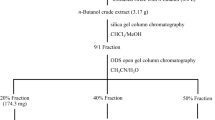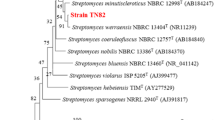Abstract
Aromatic polyketides are important therapeutic compounds which include front line antibiotics and anticancer drugs. Since most of the aromatic polyketides are known to be produced by soil dwelling Streptomyces, 54 Streptomyces strains were isolated from the soil samples. Five isolates, R1, B1, R3, R5 and Y8 were found to be potent aromatic polyketide producers and were identified by 16S rRNA gene sequencing as Streptomyces spectabilis, Streptomyces olivaceus, Streptomyces purpurascens, Streptomyces coeruleorubidus and Streptomyces lavendofoliae respectively. Their sequences have been deposited in the GenBank under the accession numbers KF468818, KF681280, KF395224, KF527511 and KF681281 respectively. The Streptomyces strains were cultivated in the media following critically optimised culture conditions. The resulting broth extracts were fractionated on a silica gel column and preparative TLC to obtain pure compounds. The pure compounds were tested for bioactivity and the most potent compound from each isolate was identified by UV–Vis, IR and NMR spectroscopic methods. Isolated S. spectabilis (R1), yielded one potent compound identified as dihydrodaunomycin with an MIC of 4 µg/ml against Bacillus cereus and an IC50 value of 24 µM against HeLa. S. olivaceus (B1), yielded a comparatively less potent compound, elloramycin. S. purpurascens (R3) yielded three compounds, rhodomycin, epelmycin and obelmycin. The most potent compound was rhodomycin with an MIC of 2 µg/ml against B. cereus and IC50 of 15 µM against HeLa. S. coeruleorubidus (R5), yielded daunomycin showing an IC50 of 10 µM and also exhibiting antimetastatic properties against HeLa. S. lavendofoliae (Y8), yielded a novel aclacinomycin analogue with IC50 value of 2.9 µM and potent antimetastatic properties at 1 µM concentration against HeLa. The study focuses on the characterization of aromatic polyketides from soil Streptomyces spp., which can serve as potential candidates for development of chemotherapeutic drugs in future.







Similar content being viewed by others
References
Anderson AS, Wellington EM (2001) The taxonomy of Streptomyces and related genera. Int J Syst Evol Microbiol 51(3):797–814
Arcamone F, Cassinelli G, Fantini G, Grein A, Orezzi P, Pol C, Spalla C (1969) Adriamycin, 14-hydroxydaimomycin, a new antitumor antibiotic from S. Peucetius var. caesius. Biotechnol Bioeng 11(6):1101–1110
Arcamone F, Cassinelli G, Franceschi G, Penco S, Pol C, Redaelli S, Selva A (1972) Structure and physicochemical properties of adriamycin (doxorubicin). In: International symposium on adriamycin, Springer, Berlin, pp. 9–22
Arifuzzaman M, Khatun MR, Rahman H (2010) Isolation and screening of actinomycetes from Sundarbans soil for antibacterial activity. Afr J Biotechnol 9:4615–4619
Arthington-Skaggs BA, Lee-Yang W, Ciblak MA, Frade JP, Brandt ME, Hajjeh RA, Harrison LH, Sofair AN, Warnock DW, Candidemia Active Surveillance Group (2002) Comparison of visual and spectrophotometric methods of broth microdilution MIC end point determination and evaluation of a sterol quantitation method for in vitro susceptibility testing of fluconazole and itraconazole against trailing and nontrailing Candida isolates. Antimicrob Agents Chemother 46(8):2477–2481
Augustine SK, Bhavsar SP, Kapadnis BP (2005) A non-polyene antifungal antibiotic from Streptomyces albidoflavus PU 23. J Biosci 30(2):201–211
Batel PL, Connors NC, Strohl WR (1990) Biosynthesis of anthracyclines: analysis of mutants of Streptomyces sp. strain C5 blocked in daunomycin biosynthesis. J Gen Microbiol 136(9):1877–1886
Begde D, Bundale S, Mashitha P, Rudra J, Nashikkar N, Upadhyay A (2011) Immunomodulatory efficacy of nisin—a bacterial lantibiotic peptide. J Pept Sci 17(6):438–444
Bervanakis G (2008) Detection and expression of biosynthetic genes in actinobacteria. Flinders University, School of Medicine, Department of Medical Biotechnology
Bouma J, Beijnen JH, Bult A, Underberg WJ (1986) Anthracycline antitumour agents. Pharm World Sci 8(2):109–133
Bundale S, Begde D, Nashikkar N, Kadam T, Upadhyay A (2014) Isolation of aromatic polyketide producing soil streptomyces using combinatorial screening strategies. OALib. https://doi.org/10.4236/oalib.preprints.1200010
Bundale S, Begde D, Nashikkar N, Kadam T, Upadhyay A (2015) Optimization of culture conditions for production of bioactive metabolites by Streptomyces spp. isolated from soil. Adv Microbiol 5(06):441–451
Dickens ML, Priestley ND, Strohl WR (1997) In vivo and in vitro bioconversion of epsilon-rhodomycinone glycoside to doxorubicin: functions of DauP, DauK, and DoxA. J Bacteriol 179(8):2641–2650
Donadio S, Maffioli S, Monciardini P, Sosio M, Jabes D (2010) Antibiotic discovery in the twenty-first century: current trends and future perspectives. J Antibiot 63(8):423–430
Dornberger K, Hübener R, Ihn W, Thrum H, Radics L (1985) Microbial conversion of daunorubicin into N-acetyl-13 (S)-dihydrodaunomycin and bisanhydro-13-dihydrodaunomycinone. J Antibiot 38(9):1219–1225
Drautz H, Reuschenbach P, Zähner H, Rohr J, Zeeck A (1985) Metabolic products of microorganisms. 225 Elloramycin, a new anthracycline-like antibiotic from Streptomyces olivaceus. J Antibiot 38(10):1291–1301
Fujiwara A, Hoshino T, Westley JW (1985) Anthracycline antibiotics. Crit Rev Biotechnol 3(2):133–157
Gebäck T, Schulz MM, Koumoutsakos P, Detmar M (2009) TScratch: a novel and simple software tool for automated analysis of monolayer wound healing assays. Biotechniques 46(4):265–274
Hertweck C, Luzhetskyy A, Rebets Y, Bechthold A (2007) Type II polyketide synthases: gaining a deeper insight into enzymatic teamwork. Nat Prod Rep 24(1):162–190
Holkar SK, Begde DN, Nashikkar NA, Kadam TA, Upadhyay AA (2013a) Optimization of some culture conditions for improved biomass and antibiotic production by Streptomyces spectabilis isolated from soil. Int J Pharm Sci Res 4(8):2980
Holkar SK, Begde DN, Nashikkar NA, Kadam TA, Upadhyay AA (2013b) Rhodomycin analogues from Streptomyces purpurascens: isolation, characterization and biological activities. SpringerPlus 2:93
Johdo O, Watanabe Y, Ishikura T, Yoshimoto A, Naganawa H, Sawa T, Takeuchi T (1991) Anthracycline metabolites from Streptomyces violaceus A262. J Antibiot 44(10):1121–1129
Kim WS, Youn DJ, Cho WT, Kim MK, Kim HR, Rhee SK, Choi ES (1995a) Improved production, and purification of aclacinomycin A from Streptomyces lavendofoliae DKRS. J Microbiol Biotechnol 5(5):297–301
Kim WS, Youn DJ, Kim HR, Rhee SK, Choi ES (1995b) Metabolic conversion of aclacinomycins B and Y to A by pH shift during fermentation with Streptomyces lavendofoliae DKRS. Biotechnol Tech 9(9):671–676
Kim HS, Hong YS, Kim YH, Yoo OJ, Lee JJ (1996) New anthracycline metabolites produced by the aklavinone 11-hydroxylase gene in Streptomyces galilaeus ATCC 31133. J Antibiot 49(4):355–360
Kitamura I, Tobe H, Yoshimoto A, Oki T, Naganawa H, Takeuchi T, Umezawa H (1981) Biosynthesis of aklavinone and aclacinomycins. J Antibiot 34(11):1498–1500
Kizek R, Adam V, Hrabeta J, Eckschlager T, Smutny S, Burda JV, Frei E, Stiborova M (2012) Anthracyclines and ellipticines as DNA-damaging anticancer drugs: recent advances. Pharmacol Ther 133(1):26–39
Kummar S, Gutierrez M, Doroshow JH, Murgo AJ (2006) Drug development in oncology: classical cytotoxics and molecularly targeted agents. Br J Clin Pharmacol 62(1):15–26
Laatsch H, Fotso S (2008) Naturally occurring anthracyclines. In: Anthracycline chemistry biology. Springer, Berlin, pp. 3–74
Liang CC, Park AY, Guan JL (2007) In vitro scratch assay: a convenient and inexpensive method for analysis of cell migration in vitro. Nat Protoc 2(2):329–333
Liu Q, Liu C, Yu J, Yan J, Qi X (2012) Analysis of the ketosynthase genes in Streptomyces and its implications for preventing reinvestigation of polyketides with bioactivities. J Agric Sci 4(7):262–270
Mosmann T (1983) Rapid colorimetric assay for cellular growth and survival: application to proliferation and cytotoxicity assays. J Immunol Methods 65(1–2):55–63
Oki T, Kitamura I, Yoshimoto A, Matsuzawa Y, Shibamoto N, Ogasawara T, Inui T, Takamatsu A, Takeuchi T, Masuda T, Hamada M (1979) Antitumor anthracycline antibiotics, aclacinomycin A and analogues. I. Taxonomy, production, isolation and physicochemical properties. J Antibiot 32(8):791–800
Rahman AM, Yusuf SW, Ewer MS (2007) Anthracycline-induced cardiotoxicity and the cardiac-sparing effect of liposomal formulation. Int J Nanomed 2(4):567–583
Roe MT, Vega E, Pillai SD (2003) Antimicrobial resistance markers for class 1 and class 2 integron-bearing Escherichia coli from irrigation water and sediments. Emerg Infect Dis 9(7):822–826
Saito S, Katsuda Y, Johdo O, Yoshimoto A (1995) New rhodomycin analogs, SS-288A and SS-288B, produced by a Streptomyces violaceus A262 mutant. Biosci Biotechnol Biochem 59(1):135–137
Shoji J, Kozuki S, Nishimura H, Mayama M, Motokawa K, Tanaka Y, Otsuka H (1968) Isolation of an antibiotic S-583-B, related to rhodomycin A and B. J Antibiot 11:643
Silverstein RM, Webster FX, Kiemle DJ, Bryce DL (2014) Spectrometric identification of organic compounds. Wiley, New York
Staley AL, Rinehart KL (1994) Spectomycins, new antibacterial compounds produced by Streptomyces spectabilis: isolation, structures, and biosynthesis. J Antibiot 47(12):1425–1433
Wang Z, Katsaros D, Shen Y, Fu Y, Canuto EM, Benedetto C, Lu L, Chu WM, Risch HA, Yu H (2015) Biological and clinical significance of MAD2L1 and BUB1 genes frequently appearing in expression signatures for breast cancer prognosis. PLoS ONE 10(8):e0136246
Workman JJ (2000) Handbook of organic compounds: NIR, IR, Raman and UV-vis spectra featuring polymers and surfactants, vol 3. Academic Press, London
Yoshimoto A, Oki T, Takeuchi T, Umezawa H (1980) Microbial conversion of anthracyclinones to daunomycin by blocked mutants of Streptomyces coeruleorubidus. J Antibiot 33(10):1158–1166
Acknowledgements
The authors would like to thank the NMR Research Centre, IISc, Bangalore and Material Science Department of VNIT, Nagpur, India for providing assistance in NMR and FT-IR analysis respectively.
Author information
Authors and Affiliations
Corresponding author
Ethics declarations
Conflict of interest
The authors declare that they have no conflict of interest.
Rights and permissions
About this article
Cite this article
Bundale, S., Begde, D., Pillai, D. et al. Novel aromatic polyketides from soil Streptomyces spp.: purification, characterization and bioactivity studies. World J Microbiol Biotechnol 34, 67 (2018). https://doi.org/10.1007/s11274-018-2448-1
Received:
Accepted:
Published:
DOI: https://doi.org/10.1007/s11274-018-2448-1




